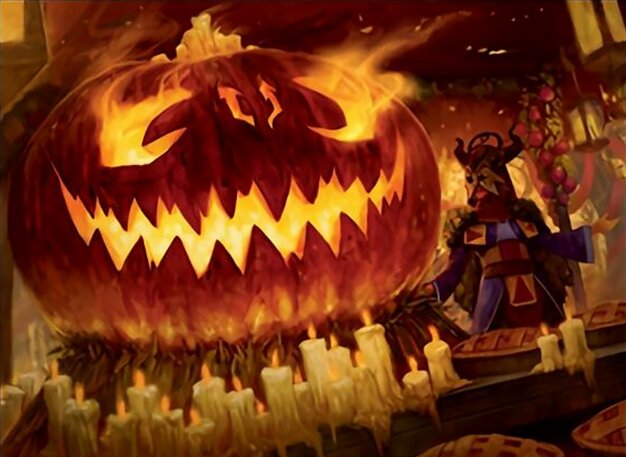Are you a Quiet Speculation member?
If not, now is a perfect time to join up! Our powerful tools, breaking-news analysis, and exclusive Discord channel will make sure you stay up to date and ahead of the curve.
Prerelease is one of the most exciting times for Magic, both from a player standpoint, and a financial standpoint. For the player, it means a fresh Limited format to dive into, new and exciting cards for constructed formats, and in the case of fall sets like Innistrad: Midnight Hunt, Standard rotation giving us an entirely new metagame to explore. From a financial standpoint, prerelease is a time to identify what are going to be hot cards and what are going to be potential sleepers, and preparing ourselves to buy and trade accordingly. With both those perspectives in mind, let's dive in and explore how to get the most from our prerelease experience.
Study The Set
The gradual reveal of spoiler season is exciting, but it can be tough to follow along with all the previews and keep up with the hype. Even if you do manage to keep up, some cards can slip through the cracks until the full set reveal the week prior to prerelease. It's certainly fun to gawk, speculate, and debate on what cards revealed by Wizards and other content creators will be powerful or interesting in given formats, but the real work to understanding a set's potential doesn't happen until we sit down and look at the complete set preview. I generally use Scryfall when looking at spoilers, or looking up cards in general. It's a great resource for finding just the card you're looking for and has lots of features for sorting, perfect for exploring a new Magic set.
Read The Rules/Mechanics Article
With the release of almost every paper Magic set, Matt Tabak, the Principal Magic Editor and former Rules Manager, writes an article for the mothership detailing the rules and mechanics relevant to the new set. His article for Innistrad: Midnight Hunt can be found here. Tabak does a great job of breaking down how each mechanic works and bringing up possible interactions or non-interactions that can occur with existing Magic cards. Magic is a complicated game, and Tabak does a fantastic job explaining the new rules and mechanics in terms any player can understand.
By reading his piece, you'll have an understanding of the mechanics of the set, making you better prepared to examine the full preview and understand how all the cards function. You'll quickly recognize what makes individual cards potentially powerful, and why. This can give you an edge not only in terms of gameplay but also financially. If you can anticipate what cards will be hot in the set, you can purchase and trade for them accordingly.
Listen To/Read Set Reviews
A new Magic set means a plethora of new content to enjoy. Content creators everywhere dig into the new set and present to their audiences the strategies, ideas, and key cards they think players will need to know. Going into prerelease, which is sealed, and as primarily a Limited player myself, I focus on consuming as much Limited content as I can. Here are a few creators to check out before you sit down to build your sealed deck:
Limited Resources
The original podcast for all things Limited, longtime host Marshall Sutcliffe and current co-host Luis Scott-Vargas do a great job breaking down every new set in their hours-long set reviews. Their in-depth, card-by-card analysis, uses a letter grade system of A-F to grade every card in the set. They also provide a sideboard grade, for powerful but narrow sideboard options. These grading systems let you see the power level of cards in relation to the other cards in the set. Following their thought processes is a great way to learn and practice card evaluation skills along with the experts.
Lords of Limited
Rather than go card by card, The Lords of Limited, Ethan Saks aka @lordtupperware, and Ben @mistermetronome, provide what they call a "Crash Course" to every new Limited format. This big picture approach looks at the value/size of creatures in the set in relation to the removal, the possible archetypes represented, and their relative powers in relation to each other. They also address more narrow concerns like the prevalence of incidental life gain and evasion abilities of creatures. They then present a breakdown of the top commons and uncommons in each color, taking into account all the considerations they've laid out.
The best part of the Lords of Limited crash courses is they do a great job of highlighting big picture themes and considerations of each set, and the key cards to look out for in each color, without bogging the listener down. It's great when you want to quickly get a grasp on a new Limited format, but don't have five hours to dedicate to listening to a review with a card-by-card breakdown.
Have Your Gear Ready
It's a terrible feeling to arrive at any Magic event and realize you're unprepared. You've forgotten your sleeves, your tokens, or worse —your deck! While forgetting a deck isn't an issue for prerelease, it's still a bummer to not be prepared. Here's a checklist of everything you should have with you to make the most of your prerelease:
Deckbox/Sleeves
While your prerelease kit will include a deck box, I generally bring my own for all my limited events. My deck box is like a mini toolkit for playing Limited. It's big enough to fit an entire sealed pool, and always stocked with sleeves, tokens relevant to the current format, and generic tokens to be used as anything I don't have. More on tokens in a bit.
I always have sleeves packed in my Limited deck box. For prerelease, I try to have enough sleeves to build two forty-card decks. Why do you ask? Because sometimes my prerelease pool is deep enough to potentially support two decks, and I'm torn between which to play. The first is usually a slower deck with more raw power, including all of my bombs and my best removal. My secondary deck is usually the option with the most consistent mana base or the better curve but lacks the raw power of the first deck. It's rare that I'll have a pool capable of building one deck that does both, but it's fantastic when it all comes together.
Having enough sleeves to easily build two decks means that for sideboarding I can have the option to sideboard into a completely different deck if it makes sense to do so in the matchup. Prerelease is also a continuous construction event, meaning I can change up my deck at any time between games and rounds. Did I decide my first deck was too inconsistent? If I have a second deck, I can just play that one instead and not have to worry about desleeving and resleeving the first.
Playmat
Playmats not only protect my cards and help define the battlefield, but they also add a touch of class to the play experience which I appreciate. It always surprises me when longtime players show up without a playmat.
Dice/Tokens
Dice are not only useful to determine who goes first but in sets that have counter themes or for representing Planeswalker loyalty they're almost a necessity. To minimize confusion, I like to always have a stack of the most common tokens in the current Limited format ready to go in my deck box. This can sometimes be difficult to do during prerelease with so many new tokens appearing, which is why I also have several generic tokens I also keep in my box as needed. My generic tokens are the old Pro Player cards that came in Tournament Packs back in the early-mid '00s. Sadly my Craig Jones card has never helped me top deck Lightning Helix.

Life Pad
There are all sorts of ways to keep track of life totals. I prefer pen and paper, and always have a notebook or life pad with me. While it's only the required form of tracking life totals at more competitive events, I find using paper and pen also allows me to take notes during my games, and it reinforces good habits for when I do play competitively.
Snacks/Drinks
Depending on your local game store (LGS)'s rules, food and drinks might be a tricky thing in the middle of the pandemic. I'd check with your LGS first about bringing in food or beverages for their policy. Having fuel to get you through a long event though can be crucial, and I try to always have water and snacks of some kind packed with me.
Trade Binder
While most of the rest of our gear list is oriented towards playing, for the financially minded among us, we can't forget to bring our trade binder if we're looking to pick up some new cards and make some deals. More on trade binders coming up.
While there may be other things you want to bring with you, this list has always helped make my event experiences better. I try to pack all of my stuff the night before the event if I have time, and I run through a mental checklist of these items before zipping my bag up and leaving it by the door.
Prepare Your Trade Binder
There is a myriad of ways to organize a trade binder. It's up to personal preference what works for you. Whatever your method, it's important to make sure your binder is stocked and sorted with a decent selection of stuff you're looking to move. Will it be everything? More likely not, but it should be a good mix of high-value, middle, and low-value cards. Depending on your collection, a mix of top-tier constructed playables and casual favorites is ideal. Try to get this organizing done several days prior to the event. It will save you the stress of scrambling to do so at the last minute.
Know What You Want To Trade For
You've studied the new set. You've prepared your trade binder. Now, what are you looking to acquire? Knowing what you're looking for before you start any trade is a great way to make every interaction quicker and smoother, saving you time and allowing you more chances to make deals. With the new set, knowing exactly what cards you're looking to pick up is helpful both because the supply will be low on prerelease weekend, and because people might be more willing to let go of potential sleeper cards on which you have your eyes set. By letting potential trade partners know upfront what you're looking for, you also save someone from having to pull out a trade binder when there is little chance of you making a deal if they don't want to.
Keep in mind that what you're looking for doesn't necessarily need to be cards from the new set. I'm currently on a mission to acquire all the Mystery Booster Playtest Cards for my Silver-Border Shenanigans Cube, so that's usually the first ask I have from any potential trading partners.
Preregister For Your Events If Possible
With the advent of the Magic Companion App, it's easier than ever to preregister for events and hold your place. Some local game stores are even set up to take payments in advance, so you only need to check-in when you arrive. This not only assures you a spot, but it also saves time and frustration on the part of the store event staff. This allows events to fire on time and run more smoothly, making for a better experience for all.
Good Luck, Have Fun
With a bit of advanced preparation prerelease can be one of the most relaxing and fun Magic playing experiences. How do you prepare for events? What are you most excited to open in your sealed pools? Let me know in the comments or on Twitter.





